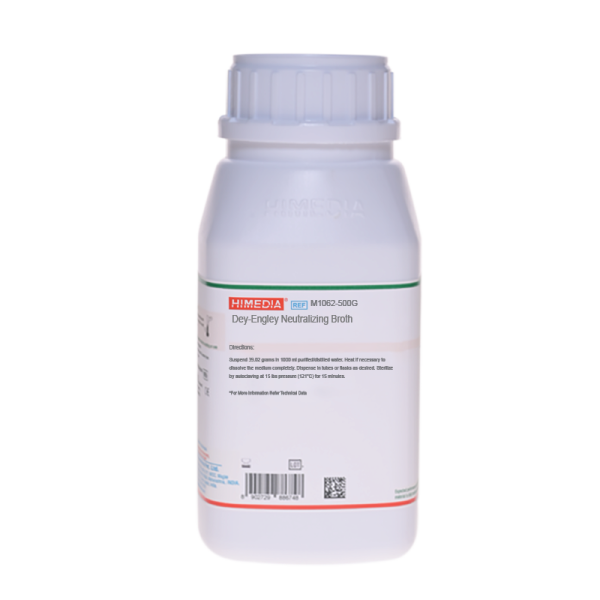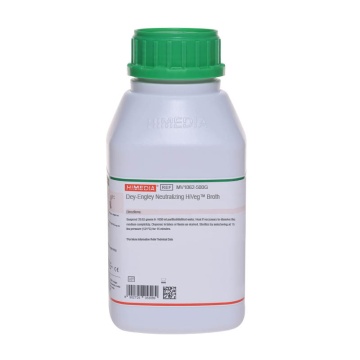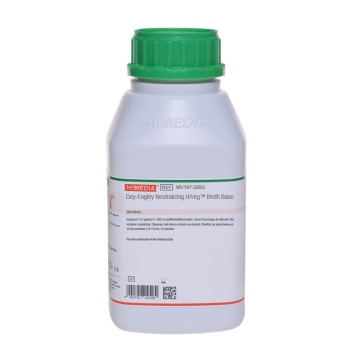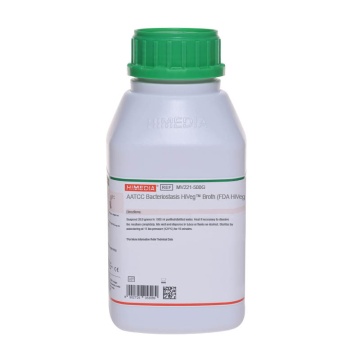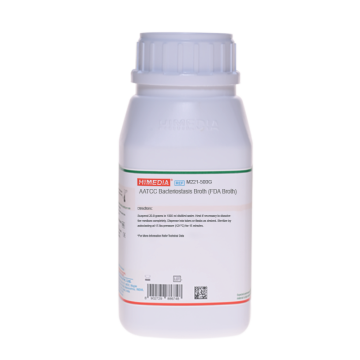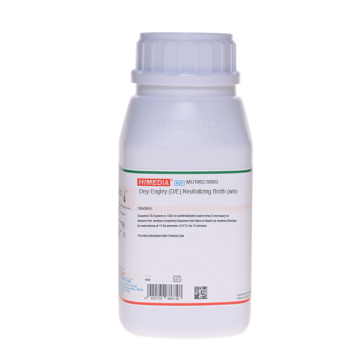 Your enquiry has been submitted
Your enquiry has been submitted
Dey-Engley Neutralizing Broth
Intended Use
Recommended for neutralizing and testing antiseptics and disinfectants.
Composition
| Ingredients | Gms / Litre |
|---|---|
| Tryptone | 5.000 |
| Yeast extract | 2.500 |
| Dextrose (Glucose) | 10.000 |
| Sodium thioglycollate | 1.000 |
| Sodium thiosulphate | 6.000 |
| Sodium bisulphite | 2.500 |
| Lecithin | 7.000 |
| Polysorbate 80 (Tween 80) | 5.000 |
| Bromocresol purple | 0.020 |
Final pH (at 25°C): 7.6±0.2
**Formula adjusted, standardized to suit performance parameters
Directions
Suspend 39.02 grams in 1000 ml purified / distilled water. Heat if necessary to dissolve the medium completely. Mix well and dispense into tubes or flasks as desired. Sterilize by autoclaving at 15 lbs pressure (121°C) for 15 minutes. Cool to 45-50°C.
Principle And Interpretation
Dey-Engley Neutralizing Broth is formulated as per the procedure described by Engley and Dey (1). Dey -Engley Neutralizing Broth is especially suited for environmental sampling where neutralization of the chemical is important to determine its bactericidal activity. A strongly bacteriostatic substance inhibits the growth and reproduction of bacteria without killing them. These bacteria hold the ability to cause infection under favourable conditions. Dey-Engley Neutralizing Broth Base and Dey-Engley Neutralizing Broth has the same formula but the former does not containing the neutralizing components.
The Dey-Engley Neutralizing Broth neutralizes a broad spectrum of antiseptics and disinfectants including quaternary ammonium compounds, phenolics, iodine and chlorine preparations, mercurials, formaldehyde and glutaraldehyde. Dey-Engley Neutralizing Broth is used for the neutralization and testing of antiseptics and disinfectants according to the procedure of Engley and Dey (1).
Tryptone provides nitrogen and carbon source, long chain amino acids, vitamins and other essential nutrients. Dextrose is an energy source. Yeast extract is also a rich source of vitamin B-complex. The present formulation incorporate neutralizing substances for almost all the active products used as antiseptics and disinfectants. Sodium bisulfite neutralizes aldehydes; sodium thioglycollate neutralizes mercurials; sodium thiosulfate neutralizes iodine and chlorine (1); lecithin neutralizes quaternary ammonium compounds; and polysorbate 80, a non-ionic surface-active agent, neutralizes substituted phenolics. Bromocresol purple is an indicator for dextrose utilization. Due to the high concentration of lecithin in the broth medium, turbidity cannot be used to detect growth. Therefore, bromocresol purple and dextrose are added to the medium. Those organisms that ferment dextrose will turn the medium from purple to yellow. Growth of Pseudomonas species, which do not ferment dextrose, can be detected by the formation of a pellicle on the surface of the broth (1).
Neutralization Test
For testing disinfectants, prepare two sets of test tubes, one containing 9 ml Dey-Engley Neutralizing Broth (M1062) and other with 9 ml Dey-Engley Neutralizing Broth Base (M187). Add 1 ml of disinfectant under test. Mix well and allow it to stand for 15 minutes. Inoculate 0.1 ml of 1:100,000 dilution of overnight broth cultures and incubate at 37°C for 48 hours. Growth is indicated by a colour change from purple to yellow or pellicle formation. Growth in Neutralizing Broth and no growth in Neutralizing Broth Base indicate neutralization of disinfectant. To check bactericidal activity, both broth tubes are inoculated on D/E Neutralizing Agar (M186). Positive growth from negative tubes of Neutralizing Broth Base indicates bacteriostatic substance while negative growth indicates a bactericidal disinfectant. All positive tubes should show growth on Dey-Engley Neutralizing Agar. The control disinfectants used in test procedure are 2% chlorine, 2% formaldehyde, 1% glutaraldehyde, 2% iodine, 2% phenol, 1/750 quaternary ammonium compounds, 1/1000 mercurials etc.
Type of specimen
Food and dairy samples; Environmental samples, cosmetic, pharmaceutical .
Specimen Collection and Handling
For food and dairy samples, follow appropriate techniques for sample collection and processing as per guidelines (2,3,4). For environmental samples, follow appropriate techniques for sample collection, processing as per guidelines and local standards (5,6).
After use, contaminated materials must be sterilized by autoclaving before discarding.
Warning and Precautions
Read the label before opening the container. Wear protective gloves/protective clothing/eye protection/ face protection. Follow good microbiological lab practices while handling specimens and culture. Standard precautions as per established guidelines should be followed while handling specimens. Safety guidelines may be referred in individual safety data sheets.
Limitations
- Due to nutritional variations, some strains may show poor growth.
Performance and Evaluation
Performance of the medium is expected when used as per the direction on the label within the expiry period when stored at recommended temperature.
Quality Control
Appearance Light yellow to bluish grey homogeneous free flowing powder
Colour and Clarity of prepared medium Purple to reddish purple coloured, opalescent solution (may have particulate precipitate) in tubes
Reaction Reaction of 3.9% w/v aqueous solution at 25°C. pH: 7.6±0.2
pH 7.40-7.80
Cultural Response
Cultural characteristics observed after an incubation at 35-37°C for 40-48 hours.
| Organism | Inoculum (CFU) | Growth |
|---|---|---|
| Bacillus subtilis subsp. spizizenii ATCC 6633 (00003*) | 50-100 | luxuriant |
| Escherichia coli ATCC 25922 (00013*) | 50-100 | luxuriant |
| Pseudomonas aeruginosa ATCC 27853 (00025*) | 50-100 | luxuriant |
| Salmonella Typhimurium ATCC 14028 (00031*) | 50-100 | luxuriant |
| Staphylococcus aureus subsp. aureus ATCC 25923 (00034*) | 50-100 | luxuriant |
| Escherichia coli ATCC 8739 (00012*) | 50-100 | luxuriant |
| Staphylococcus aureus subsp. aureus ATCC 6538 (00032*) | 50-100 | luxuriant |
Key: (*) - Corresponding WDCM numbers
Storage and Shelf Life
Store between 10-30°C in a tightly closed container and the prepared medium at 15-25°C. Use before expiry date on the label. On opening, product should be properly stored dry, after tightly capping the bottle in order to prevent lump formation due to the hygroscopic nature of the product. Improper storage of the product may lead to lump formation. Store in dry ventilated area protected from extremes of temperature and sources of ignition. Seal the container tightly after use. Product performance is best if used within stated expiry period.
Disposal
User must ensure safe disposal by autoclaving and/or incineration of used or unusable preparations of this product. Follow established laboratory procedures in disposing of infectious materials and material that comes into contact with sample must be decontaminated and disposed of in accordance with current laboratory techniques (5,6).
Reference
- Engley and Dey, 1970. Chem. Spec. Manuf. Assoc. Proc., Mid-Year Meet., p. 100.
- American Public Health Association, Standard Methods for the Examination of Dairy Products, 1978, 14th Ed., Washington D.C.
- Salfinger Y., and Tortorello M.L. Fifth (Ed.), 2015, Compendium of Methods for the Microbiological Examination of Foods, 5th Ed., American Public Health Association, Washington, D.C.
- Wehr H. M. and Frank J. H., 2004, Standard Methods for the Microbiological Examination of Dairy Products, 17th Ed., APHA Inc., Washington, D.C.
- Isenberg, H.D. Clinical Microbiology Procedures Handbook 2nd Edition.
- Jorgensen, J.H., Pfaller, M.A., Carroll, K.C., Funke, G., Landry, M.L., Richter, S.S and Warnock., D.W. (2015) Manual of Clinical Microbiology, 11th Edition. Vol. 1.
| Product Name | Dey-Engley Neutralizing Broth |
|---|---|
| SKU | M1062 |
| Product Type | Regular |
| Physical Form | Powder |
| Origin | Animal |
| Packaging type | HDPE |
| References | 1. Engley and Dey, 1970. Chem. Spec. Manuf. Assoc. Proc., Mid-Year Meet., p. 100. |
| Customized Product Available | No |



